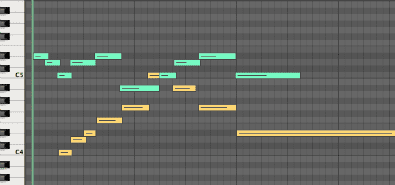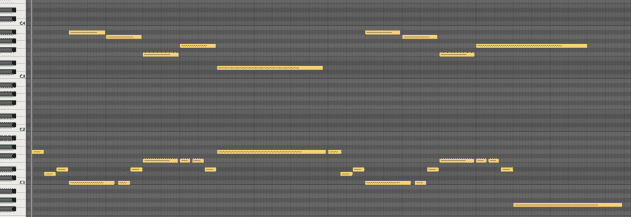Lorn – ‘Ghosst’
Let’s take a more detailed look at a simple but effective use of counterpoint in Lorn’s track ‘Ghosst’, taken from his 2012 album Ask The Dust.
At 0:48, while the bassline continues, a new lead melody line plays on top:
Both these melodies clearly work well separately, but there are a number of things that work particularly well when we look at them together.
Firstly, we can see that when the phrase is repeated the second time, both melodies end on the root note of the scale, G. We can hear how this ‘unifies’ the two separate melodies, resolving together at the end.
Secondly, looking at the melodies together, we can see that, with the exception of the last note, G, their trajectories move in opposite directions. This is a great example of ‘contrary motion’ which we discussed in a previous Passing Notes.
Counterpoint in practice
Let’s take a further look at how counterpoint can be employed in practice. In the example below we’ve created a loop using some synth string chords and a simple piano melody on top:
In this second version of the loop, however, we’ve panned the first melody to the right. The second melody that comes in on top, panned to the left, works independently but also complements the original melody without simply harmonising every note.
Notice how in our example the melodies are panned to either side of the mix. We’ve also used a different piano sound for each part to help separate them further. Techniques such as these can obviously be useful for separation from a mixing perspective, as the two parts will share the same frequency range. Having different lines separated in this way (be it via panning, timbre or instrumentation) allows the melodies to operate distinctly as well as complementing each other.




08.28 PM
Superb as ever. Thank you.
10.36 PM
very useful!
11.08 AM
You guys are great! Thanks!!!
06.37 PM
really nice. If anyone else is wanting to get deeper into counterpoint you should check this book out
http://www.opus28.co.uk/Fux_Gradus.pdf
Its really old and super hard read lol but definitely useful if you can get through it! Good examples if you can read basic notation. I love this site though
10.36 AM
Just started to study counterpoint. A vast subject, but I really enjoyed the summary here and the examples of modern artists using it.
10.29 AM
E – Thank You VERY much for this wonderful book, this truly seems to be a read worthwhile!
06.30 AM
youtube video is missing